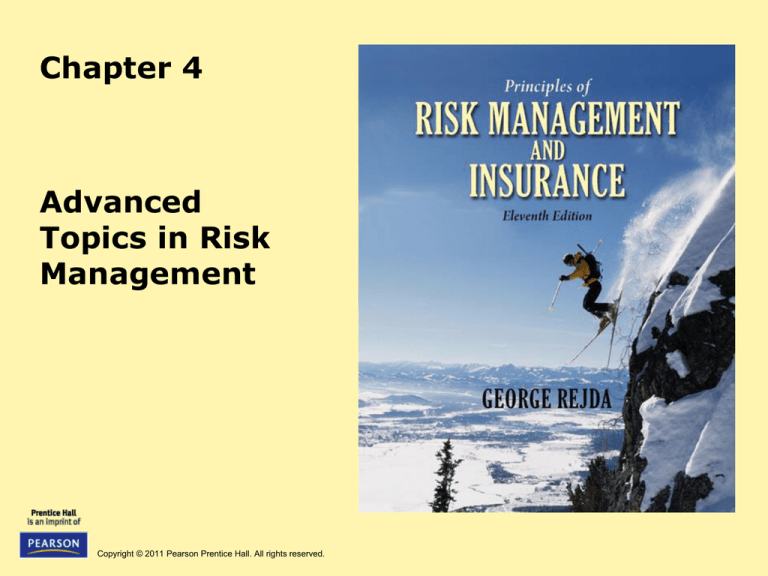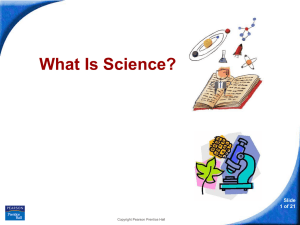
Chapter 4
Advanced
Topics in Risk
Management
Copyright © 2011 Pearson Prentice Hall. All rights reserved.
Agenda
•
•
•
•
•
The Changing Scope of Risk Management
Enterprise Risk Management
Insurance Market Dynamics
Loss Forecasting
Financial Analysis in Risk Management
Decision Making
• Other Risk Management Tools
Copyright © 2011 Pearson Prentice Hall. All rights reserved.
4-2
The Changing Scope of Risk Management
• Today, the risk manager’s job:
– Involves more than simply purchasing
insurance
– Is not limited in scope to pure risks
• The risk manager may be using:
– Financial risk management
– Enterprise risk management
Copyright © 2011 Pearson Prentice Hall. All rights reserved.
4-3
The Changing Scope of Risk Management
• Financial Risk Management refers to the identification,
analysis, and treatment of speculative financial risks:
– Commodity price risk is the risk of losing money if the price of
a commodity changes
– Interest rate risk is the risk of loss caused by adverse interest
rate movements
– Currency exchange rate risk is the risk of loss of value caused
by changes in the rate at which one nation's currency may be
converted to another nation’s currency
• Financial risks can be managed with capital market
instruments
Copyright © 2011 Pearson Prentice Hall. All rights reserved.
4-4
Exhibit 4.1 Managing Financial Risk—Two
Examples
Copyright © 2011 Pearson Prentice Hall. All rights reserved.
4-5
Exhibit 4.1 Managing Financial Risk—Two
Examples
Copyright © 2011 Pearson Prentice Hall. All rights reserved.
4-6
The Changing Scope of Risk Management
• An integrated risk management program is a
risk treatment technique that combines
coverage for pure and speculative risks in
the same contract
• A double-trigger option is a provision that
provides for payment only if two specified
losses occur
• Some organizations have created a Chief
Risk Officer (CRO) position
– The chief risk officer is responsible for the
treatment of pure and speculative risks faced by
the organization
Copyright © 2011 Pearson Prentice Hall. All rights reserved.
4-7
Enterprise Risk Management
• Enterprise Risk Management (ERM) is a comprehensive
risk management program that addresses the
organization’s pure, speculative, strategic, and operational
risks
– Strategic risk refers to uncertainty regarding an organization’s
goals and objectives
– Operational risks are risks that develop out of business
operations, such as product manufacturing
– As long as risks are not positively correlated, the combination
of these risks in a single program reduces overall risk
– Nearly half of all US firms have adopted some type of ERM
program
– Barriers to the implementation of ERM include organizational,
culture and turf battles
Copyright © 2011 Pearson Prentice Hall. All rights reserved.
4-8
The Financial Crisis and
Enterprise Risk Management
• The US stock market dropped by more
than fifty percent between October 2007
and March 2009
– The meltdown raises questions about the use
of ERM
– Only 18 percent of executives surveyed said
they had a well-formulated and fullyimplemented ERM program
Copyright © 2011 Pearson Prentice Hall. All rights reserved.
4-9
Exhibit 4.2
Timeline of
Events Related
to the Financial
Crisis
Copyright © 2011 Pearson Prentice Hall. All rights reserved.
4-10
The Financial Crisis and Enterprise
Risk Management
• AIG mentions an active ERM program in its 2007 10-K
Report
– Riskiness of the Financial Products Division was not fully
appreciated
• The division was issuing credit default swaps
• A credit default swap is an agreement in which the risk of default of
a financial instrument is transferred from the owner of the financial
instrument to the issuer of the swap
• The default rate on mortgages soared and the company did not
have the capital to cover guarantees
• The lessons learned by risk managers from the financial
crisis will influence ERM in the future
Copyright © 2011 Pearson Prentice Hall. All rights reserved.
4-11
Insurance Market Dynamics
• Decisions about whether to retain or transfer risks are
influenced by conditions in the insurance marketplace
• The Underwriting Cycle refers to the cyclical pattern of
underwriting stringency, premium levels, and profitability
– “Hard” market: tight standards, high premiums, unfavorable
insurance terms, more retention
– “Soft” market: loose standards, low premiums, favorable
insurance terms, less retention
– One indicator of the status of the cycle is the combined ratio:
Combined Ratio
Paid Losses Loss Adjustment Expenses Underwriting Expenses
Premiums
Copyright © 2011 Pearson Prentice Hall. All rights reserved.
4-12
Exhibit 4.3 Combined Ratio for All Lines of
Property and Liability Insurance, 1956–2008*
Copyright © 2011 Pearson Prentice Hall. All rights reserved.
4-13
Insurance Market Dynamics
• Many factors affect property and liability
insurance pricing and underwriting decisions:
– Insurance industry capacity refers to the relative level of
surplus
• Surplus is the difference between an insurer’s assets and its
liabilities
• Capacity can be affected by a clash loss, which occurs when
several lines of insurance simultaneously experience large
losses
– Investment returns may be used to offset underwriting
losses, allowing insurers to set lower premium rates
Copyright © 2011 Pearson Prentice Hall. All rights reserved.
4-14
Insurance Market Dynamics
• The trend toward consolidation in the financial services
industry is continuing
– Consolidation refers to the combining of businesses through
acquisitions or mergers
• Due to mergers, the market is populated by fewer, but larger
independent insurance organizations
• There are also fewer large national insurance brokerages
– An insurance broker is an intermediary who represents insurance
purchasers
– Cross-Industry Consolidation: the boundaries between insurance
companies and other financial institutions have been struck down
• Financial Services Modernization Act of 1999
• Some financial services companies are diversifying their operations by
expanding into new sectors
Copyright © 2011 Pearson Prentice Hall. All rights reserved.
4-15
Capital Market Risk Financing
Alternatives
• Insurers are making increasing use of capital
markets to assist in financing risk
– Securitization of risk means that insurable risk is
transferred to the capital markets through creation of a
financial instrument:
• A catastrophe bond permits the issue to skip or defer
scheduled payments if a catastrophic loss occurs
– An insurance option is an option that derives value from
specific insurance losses or from an index of values.
• A weather option provides a payment if a specified weather
contingency (e.g., high temperature) occurs
– The impact of risk securitization is an increase in capacity
for insurers and reinsurers
• It provides access to the capital of many investors
Copyright © 2011 Pearson Prentice Hall. All rights reserved.
4-16
Exhibit 4.4 Catastrophe Bonds: Annual Number of
Transactions and Issue Size
Copyright © 2011 Pearson Prentice Hall. All rights reserved.
4-17
Loss Forecasting
• The risk manager can predict losses using
several different techniques:
– Probability analysis
– Regression analysis
– Forecasting based on loss distribution
• Of course, there is no guarantee that
losses will follow past loss trends
Copyright © 2011 Pearson Prentice Hall. All rights reserved.
4-18
Loss Forecasting
• Probability analysis: the risk manager can assign
probabilities to individual and joint events
– The probability of an event is equal to the number of
events likely to occur (X) divided by the number of
exposure units (N)
• May be calculated with past loss data
– Two events are considered independent events if the
occurrence of one event does not affect the occurrence
of the other event
– Two events are considered dependent events if the
occurrence of one event affects the occurrence of the
other
– Events are mutually exclusive if the occurrence of one
event precludes the occurrence of the second event
Copyright © 2011 Pearson Prentice Hall. All rights reserved.
4-19
Loss Forecasting
• Regression analysis characterizes the
relationship between two or more variables
and then uses this characterization to
predict values of a variable
– For example, the number of physical damage
claims for a fleet of vehicles is a function of the
size of the fleet and the number of miles driven
each year
Copyright © 2011 Pearson Prentice Hall. All rights reserved.
4-20
Exhibit 4.5 Relationship Between Payroll and
Number of Workers Compensation Claims
Copyright © 2011 Pearson Prentice Hall. All rights reserved.
4-21
Loss Forecasting
• A loss distribution is a probability distribution
of losses that could occur
– Useful for forecasting if the history of losses tends
to follow a specified distribution, and the sample
size is large
– The risk manager needs to know the parameters
of the loss distribution, such as the mean and
standard deviation
– The normal distribution is widely used for loss
forecasting
Copyright © 2011 Pearson Prentice Hall. All rights reserved.
4-22
Financial Analysis in Risk Management
Decision Making
• The time value of money must be considered when
decisions involve cash flows over time
– Considers the interest-earning capacity of money
– A present value is converted to a future value through
compounding
– A future value is converted to a present value through
discounting
• Risk managers use the time value of money when:
– Analyzing insurance bids
– Making loss control investment decisions
• The net present value is the sum of the present values of the future
cash flows minus the cost of the project
• The internal rate of return on a project is the average annual rate
of return provided by investing in the project
Copyright © 2011 Pearson Prentice Hall. All rights reserved.
4-23
Other Risk Management Tools
• A risk management information system (RMIS) is a
computerized database that permits the risk manager to store
and analyze risk management data
– The database may include listing of properties, insurance policies,
loss records, and status of legal claims
– Data can be used to predict and attempt to control future loss
levels
• Risk Management Intranets and Web Sites
– An intranet is a web site with search capabilities designed for a
limited, internal audience
• A risk map is a grid detailing the potential frequency and
severity of risks faced by the organization
– Each risk must be analyzed before placing it on the map
Copyright © 2011 Pearson Prentice Hall. All rights reserved.
4-24
Other Risk Management Tools
• Value at risk (VAR) analysis involves calculating the worst
probable loss likely to occur in a given time period under
regular market conditions at some level of confidence
– The VAR is determined using historical data or running a
computer simulation
– Often applied to a portfolio of assets
– Can be used to evaluate the solvency of insurers
• Catastrophe modeling is a computer-assisted method of
estimating losses that could occur as a result of a catastrophic
event
– Model inputs include seismic data, historical losses, and values
exposed to losses (e.g., building characteristics)
– Models are used by insurers, brokers, and large companies with
exposure to catastrophic loss
Copyright © 2011 Pearson Prentice Hall. All rights reserved.
4-25







